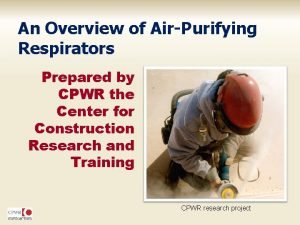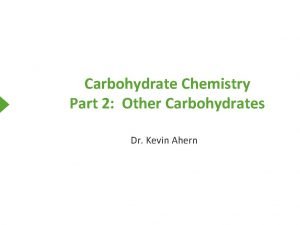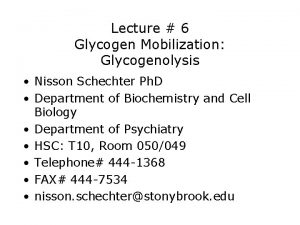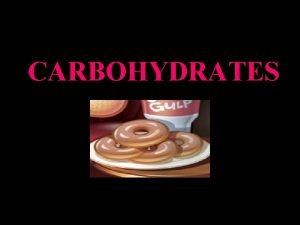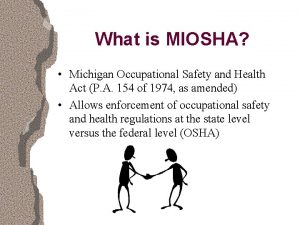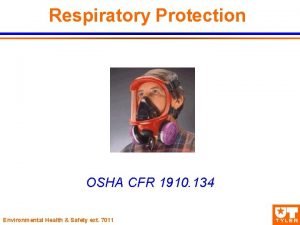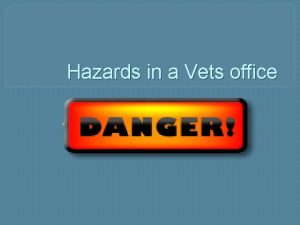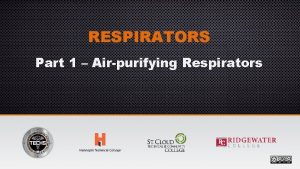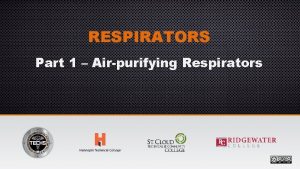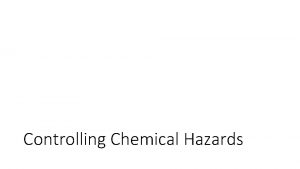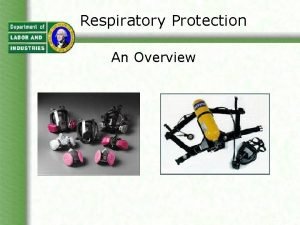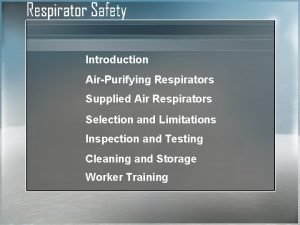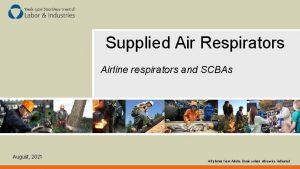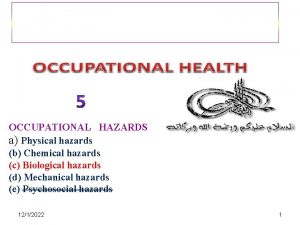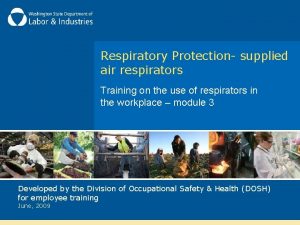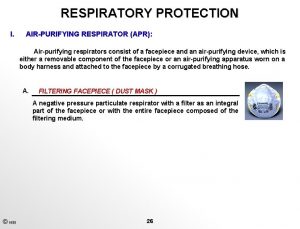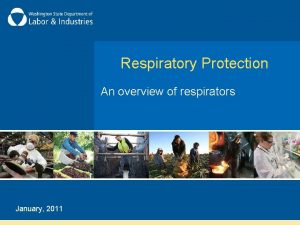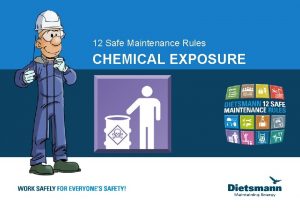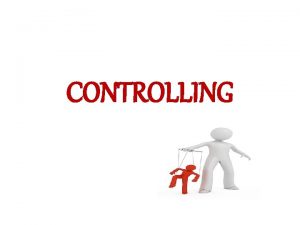Controlling Chemical Hazards Reducing Exposure Respiratory Protection Respirators


















- Slides: 18

Controlling Chemical Hazards

Reducing Exposure: Respiratory Protection

Respirators are incompatible with facial hair!

Respiratory Protection Questions: • How do you know when respiratory protection is required? • How to select the appropriate PPE? • How to manage the use, care and maintenance of the selected PPE?

How do you know when respiratory protection is required? • Typically respirators are used to reduce a workers exposure below an established regulatory occupational exposure limit (OEL) and only when other controls (i. e. ventilation) is not effective or feasible • Respirators can be worn to provide relief from nuisance odors

There is no assigned protection factor for surgical type facemasks

Concentration Outside Respirator = 100 mg/m 3 Concentration Inside Respirator = 75 - 100 mg/m 3

PARTICLES / DUST Less Protective Nuisance level protection only. Not for protection approaching or above OEL (large particles only) Nuisance and OEL exceedance protection (in some cases) Used to protect exposures exceeding OEL More Protective CHEMICALS Little to no protection against chemical exposures

IMPORTANT – Activated carbon does not adsorb some chemicals well There are several types of filter cartridges each with different sorbants • • • Organic Vapor Inorganic Vapor Acid Gas Ammonia Formaldehyde Mercury Vapor

How long with the activated carbon last? Example: • The exposure of gluing workers range: Methyl Ethyl Ketone (MEK) 5 -10 ppm Cyclohexane 10 -15 ppm Not Recommended: no quantifiable protection Would provide low level protection, but would need to be changed at minimum daily

Dust/Particulate Respirators • Disposable Respirators or Cartridge Filters should be replaced whenever: • Damaged • Soiled • Noticeably increased breathing resistance (e. g. , causing discomfort to the wearer). • Dust loading is > 200 mg dust

Fit Testing • Workers required to wear respirators must be fit tested • Just like all PPE respirators come in different sizes • If the respirator does not fit properly it cannot provide a guaranteed level of protection

Maintenance and Care • Poor maintenance can significantly reduce the life span of respiratory protection equipment. Good Practices include: • Storage in clean areas (away from chemicals) • Do not hang from straps (elasticity will decrease faster) • Regular cleaning and disinfecting of non disposal respirators

Respiratory Protection Plan Type of Respirator Cartridge 3 M 9913 Nuisance level organic solvents 3 M 6000 Half-face Respirator with OV cartridges Location or Job Duties Chemicals in Use Replacement Schedule Screen Printing and cleaning MEK Daily Chemical Mixing room Cyclohexanone Cyclohexane MEK Acetone Hexane Cartridge change every 4 days

Example – Online Service Life Calculator *Source: 3 M http: //extra 8. 3 m. com/SLSWeb/service. Life. Disclaimer. html? regl. Id=20&lang. Code=EN&country. Name=United%20 States

Respirator Selection Process - General Determine what chemical(s) the worker is potentially exposed to (SDS review) Move through Hierarchy of Controls Is substitution or ventilation an option? Conduct Indoor air measurements to evaluate the level of chemical(s) in the air Above or Below OEL? Determine the type of respirator required (OEL vs nuisance protection) Develop Respirator Protection Plan: FIT Testing Training Change out Schedules

Is 2 better than 1? Wearing a surgical mask under a respirator, makes the respirator LESS EFFECTIVE

This work is licensed under the Creative Commons Attribution 4. 0 International License. To view a copy of this license, visit http: //creativecommons. org/licenses/by/4. 0/.
 Types of respirators n r p
Types of respirators n r p Managing economic exposure and translation exposure
Managing economic exposure and translation exposure Managing economic exposure and translation exposure
Managing economic exposure and translation exposure Eksposur translasi adalah
Eksposur translasi adalah Transaction exposure and economic exposure
Transaction exposure and economic exposure Reducing vs non reducing sugar
Reducing vs non reducing sugar Reducing and non reducing sugar
Reducing and non reducing sugar Glucose versus glycogen
Glucose versus glycogen Difference between reducing and non reducing sugars
Difference between reducing and non reducing sugars Conducting zone and respiratory zone
Conducting zone and respiratory zone Miosha respiratory protection standard
Miosha respiratory protection standard Osha 1910-134
Osha 1910-134 Chemical hazards in a veterinary clinic
Chemical hazards in a veterinary clinic Section 1 chemical changes
Section 1 chemical changes Love formula
Love formula Section 2 classifying chemical reactions worksheet answers
Section 2 classifying chemical reactions worksheet answers Chapter 18 chemical reactions balancing chemical equations
Chapter 18 chemical reactions balancing chemical equations Section 2 classifying chemical reactions worksheet answers
Section 2 classifying chemical reactions worksheet answers Chapter 7 review chemical formulas and chemical compounds
Chapter 7 review chemical formulas and chemical compounds
